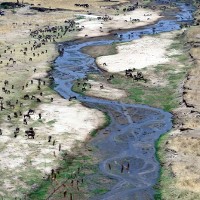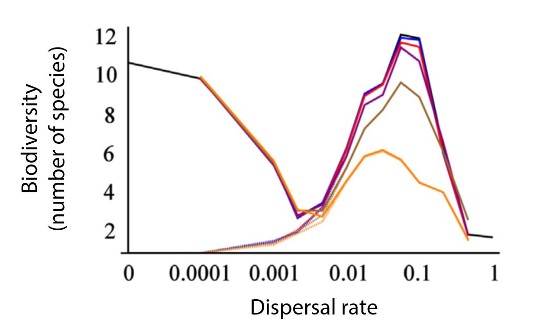Eco-evolutionary dynamics of living systems: Applications
EEP’s research elucidates the extent to which eco-evolutionary dynamics may aggravate the global biodiversity crisis and helps to identify mitigating mechanisms that show promise. An important theme for the program in 2015 was how animal movement and plant dispersal influence eco-evolutionary dynamics and, more broadly, the maintenance of biodiversity.
- EEP research revealed how anthropogenic changes in spatial heterogeneities and environmental correlations across a network of ecological habitats decrease the biodiversity protection associated with animal and plant dispersal [1] (Figure 1).
- A complementary study investigated the evolution of dispersal distances and identifying how dispersal patterns depend on competition intensity, dispersal costs, and maternal investments [2].
- Responding to the growing need to model animal movements more realistically, EEP is extending the well-established Brownian-bridge method for predicting animal movement on the basis of positional data, such as may be obtained from GPS collars [3].
- Focusing on interactions between animal movement and phenotypic plasticity, EEP research has elucidated the conditions that facilitate the emergence of two species from a common ancestor [4].
- Recognizing that the movements of many species change with the presence or absence of predators, a new study investigated when such reactive movements stabilize ecological dynamics and how to account for them in the functional responses of ecological models [5].
- As animal movements frequently result in encounters with conspecifics, it is important to understand how these encounters affect eco-evolutionary dynamics. A recent EEP study of four widely considered interference mechanisms revealed their impacts on the ecology and evolution of populations and communities [6].
- Tailoring an eco-evolutionary model to river systems, EEP research demonstrated the crucial role that the evolution of dispersal plays for species in these systems, while simultaneously demonstrating the importance of riffles, pools, and run zones in maintaining biodiversity [7].
Figure 1. According to the spatial insurance hypothesis, biodiversity in spatially distributed ecological communities is protected by dispersal, peaking at intermediate dispersal rates (black curve). New research reveals how this effect is eroded when dispersal rates become more and more spatially heterogeneous (transition from black to blue, red, purple, brown, and orange curves) [1].
References
[1] Shanafelt DW, Dieckmann U, Jonas M, Franklin O, Loreau M & Perrings C (2015). Biodiversity, productivity, and the spatial insurance hypothesis revisited. Journal of Theoretical Biology 380: 426–435
[2] Fronhofer EA, Poethke HJ & Dieckmann U (2015). Evolution of dispersal distance: Maternal investment leads to bimodal dispersal kernels. Journal of Theoretical Biology 365: 270–279.
[3] de Barros AE, Landi P, Hui C, Brännström Å & Dieckmann U. Individual-based movement models as a tool to assess statistical estimation methods applied to animal movements, in preparation.
[4] Nonaka E, Svanbäck R, Thibert-Plante X, Englund G & Brännström Å (2015). Mechanisms by which phenotypic plasticity affects adaptive divergence and ecological speciation. American Naturalist 186: E126.
[5] Sjödin H, Brännström Å & Englund G (2015). Space-race functional responses. Proceedings of the Royal Society B 282: 20142121.
[6] Zhang L, Andersen KH, Dieckmann U & Brännström Å (2015). Four types of interference competition and their impacts on the ecology and evolution of size-structured populations and communities. Journal of Theoretical Biology 380: 280–290.
[7] Mazzucco R, Van Nguyen T, Kim DH, Chon TS & Dieckmann U (2015). Adaptation of aquatic insects to the current flow in streams. Ecological Modelling 309–310: 143–152.

CONTACT DETAILS
Principal Research Scholar Exploratory Modeling of Human-natural Systems Research Group - Advancing Systems Analysis Program
Principal Research Scholar Systemic Risk and Resilience Research Group - Advancing Systems Analysis Program
Principal Research Scholar Cooperation and Transformative Governance Research Group - Advancing Systems Analysis Program
Research program



